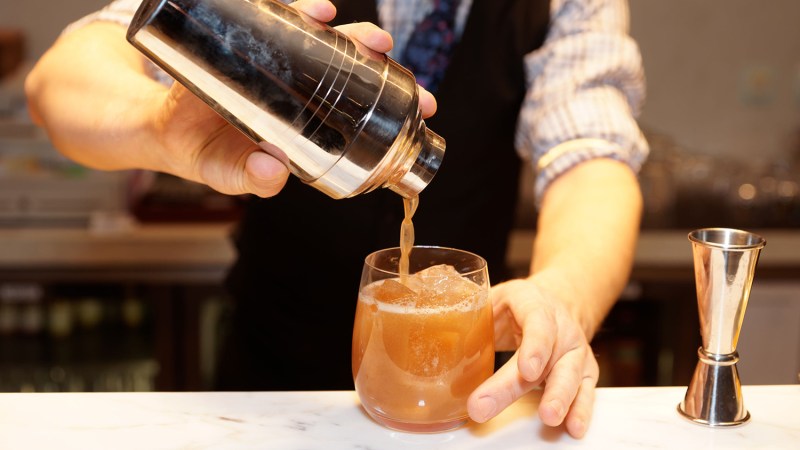You finally did it: your bar is stocked, your cocktail shaker is glistening, and you’ve carefully laid out a bowl of citrus fruit. Now, how the hell do you make a cocktail? The finesse of marrying ingredients will come in time, but there are a few essential mixing techniques that you can master in no time. Rashid Barrett, Seven Grand Austin’s Spirit Guide, gave us the skinny on how to navigate these methods. If you think your arms can handle it, here’s how to get shaking.
Stir

Tools: a mixing glass, barspoon, and julep strainer
Time: 45 to 120 seconds
“Almost all cocktails that are spirit forward, such as the Manhattan or Bobby Burns, are stirred in a mixing glass,” says Barrett. A stirred cocktail should have a velvety, smooth mouthfeel that embraces the liquor within it. When it comes to mixing techniques, it’s easy for a beginner to underestimate the complexity of stirring. While your main concern might be dilution or effective chilling, you also need to be wary of aerating the mix too much with clumsy stirring.
Barrett recommends using a Yarai mixing glass julep strainer
“Stirred cocktails are among the easiest to manage because you are able to taste your product to check for both temperature and dilution,” says Barrett, suggesting a straw for tasting purposes. “If you don’t stir long enough, you end up with a tiny cocktail and slightly higher potency. Stir too long, it’s likely you have watered the cocktail down.”
Roll

Tools: two shaker tins and a strainer (Hawthorne or julep)
Time: 15 to 60 seconds
A roll is most commonly used on a Bloody Mary because it’s the most effective way to chill and mix the drink without thinning the tomato juice. This is the best of the mixing techniques for carbonated drinks to avoid pressurizing the mix in a shaker or flattening the drink with a stir. You should fill one tin a little more than halfway with ice and secure the ice with a strainer of your choice. In the other tin, you’ll build your cocktail before pouring it into the other tin. Transfer the mix no more than four times, and then pour the drink into a serving glass.
An advanced version of the roll is called “throwing.” Popular in Spain, Cuba, and bar tending competitions across the world, throwing emphasizes the distance between the tins. Used for drinks featuring wine elements like sherry or vermouth, throwing is a dramatic way to aerate the mix. One tin can be as high as your head while the other is as low as your knee and you can transfer the mix a few more times than you would with a traditional roll. Be warned: this is a messy method; start out with water and work your way up.
Dry Shake/Whip

Tools: a cocktail shaker and a mixer tin (optional)
Time: 15 to 60 seconds
Dry shakes or whips are used to mix ingredients with very different textures (such as cream or eggs) and/or for drinks served on the rocks. “Traditional sours, for example, require a little more work because you’re emulsifying an egg with booze which requires most barmen/women to apply a hefty dry shake before introducing ice for a final shake,” says Barrett.
A simple enough method, dry shakes just require you to shake up a built cocktail. You then have the option of adding ice to the shaker and doing a rocks shake. You can also do a reverse dry shake if you’re interested in getting a very pronounced foam in your final drink. For this technique, you just do a rocks shake, strain your mix into a mixer tin, discard the ice, and a re-mix your drink until you achieve the desired effect.
Rocks Shake

Tools: a cocktail shaker
Time: 10 to 45 seconds
This shake has the most artistic liberty of them all. The size of your ice, how long you shake your mix, and how intensely you shake will all have an effect on your drink. No one really wants an over-diluted drink, but you need to weigh the temperature of the drink against the taste.
“It’s equally as important to listen to the ice in the shaker while you’re shaking,” says Bennett after underscoring the importance of adding your ice last. “If you can hear the ice exploding and disintegrating into shards from your herculean muscles, more than likely you’ve over-diluted your beverage.”


